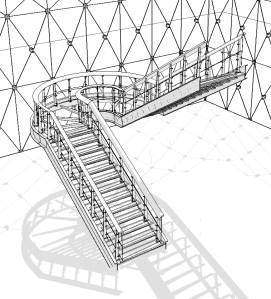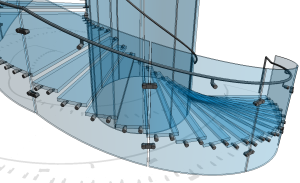>
[ Co-posted on “All Things BIM” ]
Yet another organization in the United States has hopped on the BIM wagon…this time it’s Indiana University (IU). I recently had the opportunity to speak with Theresa Thompson LEED AP, the Director of In-House Projects & Spatial/Project Information at the University Architect’s Office about their new BIM requirements and associated documentation.
Over the last two years, Indiana University has been embracing the use of building information modeling to expand and enhance their commitment to sustainable design and efficient use of funding through lifecycle data management. This journey began with various GIS and facility management implementations and has come full circle to encompass the building design and construction domain.
Earlier in 2009, IU had a positive experience with BIM – going literally from light table coordination to virtual building model – on the completed Innovation Center at their Bloomington campus. Messer Construction Company led the effort by generating models of the design data from BSA LifeStructures, ensuring a successful project delivery and a happy client in IU. In October 2009, the university announced that it would require the use of BIM tools and processes for all capital projects over 5 million dollars and on all projects within the next year or two.
Standards and Guidelines
IU has made the following documents available on their website:
- BIM Requirements Presentation
- BIM Guidelines and Standards
- BIM Proficiency Matrix
- BIM Execution Plan Template
- IPD Template
- Revit CAD Layer export template
- Revit CAD import lineweights file
Goals and objectives
The following are the key objectives behind the IU BIM/IPD program:
- Capture information early and throughout the design/construction process
- Improved change management
- Better construction documents and as-builts
- Database links to FM / Campus Management
- Decrease cost of managing information and facilities
- Improved energy conservation
- Establish standards for the future
Top-Level Takeaways
Beyond the usual standards and protocols, here are a few interesting highlights I found while reading the IU documents.
- IU requires Revit as the BIM format deliverable
- “The model managers from all parties will establish modeling standards and guidelines.”
- “The architect’s model manager should coordinate with the consulting engineers’ model managers to eliminate duplicate or redundant objects.”
- “The Architectural and Consulting Engineers’ models will be revised throughout construction, based on owner directives and As Built comments. The models will always reflect the revised contract documents.”
- Definition of “Level One, Level Two and Level Three Collisions” (see BIM Guidelines and Standards)
- COBIE Design Data required
- Energy Modeling – “After building completion and occupancy of a minimum of one year, actual building performance shall be evaluated against this model.”
By focusing on data reuse for facility management, Indiana University presents a clear understanding of their objectives in requiring a BIM/IPD process. At the same time, IU is still learning about the process by placing much of the design and construction BIM standards in the hands of the architects, engineers and contractors. These documents and others listed below can help the AEC industry continue to improve its efficiency and can also assist those just learning about the implementation of building information modeling and integrated project delivery.
 BIM Proficiency Matrix (BPM)
BIM Proficiency Matrix (BPM)
Other recently published BIM standards:
Wisconsin BIM Standards: http://www.doa.state.wi.us/dsf/masterspec_view_new.asp?catid=61&locid=4
US Army Corps of Engineers, New York District BIM Standards:
http://www.nan.usace.army.mil/business/buslinks/contract/ae/index.htm
















